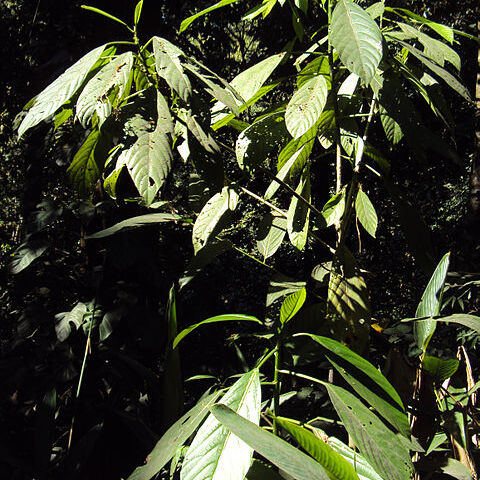Shrubs or small trees, 3-7 m tall; branchlets spreading, semiwoody; bark gray-green; upper stem and branchlets sparsely armed with stinging hairs. Stipules brownish, caducous, ovate-lanceolate, ca. 1.5-2.5 cm, subleathery, puberulent abaxially; petiole 2-10 cm, sparsely pubescent and armed with stinging hairs; leaf blade elliptic, oblong-or obovate-lanceolate, rarely rhombic, 10-45 × 5-20 cm, leathery or papery, penniveined, lateral veins 8-15 each side, anastomosing before margin, prominent abaxially, both surfaces subglabrous or sparsely armed with stinging hairs on veins, base cuneate, rounded, or deeply cordate, margin entire, sinuate to irregularly denticulate, apex acute to long acuminate; cystoliths minutely punctiform, conspicuous adaxially. Male inflorescences in distal axils of branchlets, long paniculate, 5-10 cm; armed with stinging hairs; female inflorescences also in distal axils, 10-20 cm. Male flowers subsessile, in bud 1.2 mm; perianth lobes 4, ovate, pubescent and armed with short stinging hairs; stamens 4; rudimentary ovary obovoid, 0.5 mm. Female flowers: pedicels often fleshy but not swollen; perianth lobes 4, unequal, 1-1.5 mm. Ovary ca. 1.5 mm; stigma ligulate, ca. 2 mm. Achene asymmetrically pyramidal, 5-6 mm, conspicuously verrucose; persistent perianth forming a minute cupule at base. Fl. Sep-Apr, fr. Sep-Nov.
More
Tree to 10 m high, dioecious; stems hollow. Leaves not peltate; lamina elliptic, subentire to crenate or sinuate, acuminate apex, rounded to shallowly cordate at base, 15–40 cm or more long, deep green, glossy, with sparse stinging hairs especially on veins beneath, glabrescent; petiole c. 2–15 cm long; stipules c. 2 cm long. Panicles lax, solitary, 5–30 cm long, with many stinging hairs; female inflorescences longer than male; flowers minute, green, shortly pedicellate. Male flowers 4-merous, perianth segments c. 2 mm long. Female flowers: perianth tubular, 4-lobed, c. 1 mm long, persistent; stigma c. 4–9 mm long, minutely hairy. Achenes erect, ovoid, 4–5 mm long, beaked, somewhat compressed, rugose, with perianth enclosing base.
A shrub. It can grow 5 m tall. It has soft stems. The young parts have stinging hairs. The leaves are large and oval. They can have notches near the tip. The flowers are white.
Grows as a weedy species, colonising gaps in the forest. Frequent along roads and tracks throughout the island, as it regenerates quickly from branches that become broken and buried during the construction and maintenance of roads and tracks.
More
A weedy species, colonizing gaps in the forest, locally frequent along roads and tracks, and is commonly found in relatively dry forest on sandy soils; at elevations from sea-level up to 1,400 metres.
It is a subtropical plant. It grows in wet evergreen forests in Asia. It usually grows between 300-850 m above sea level but can grow to 1,200 m.

